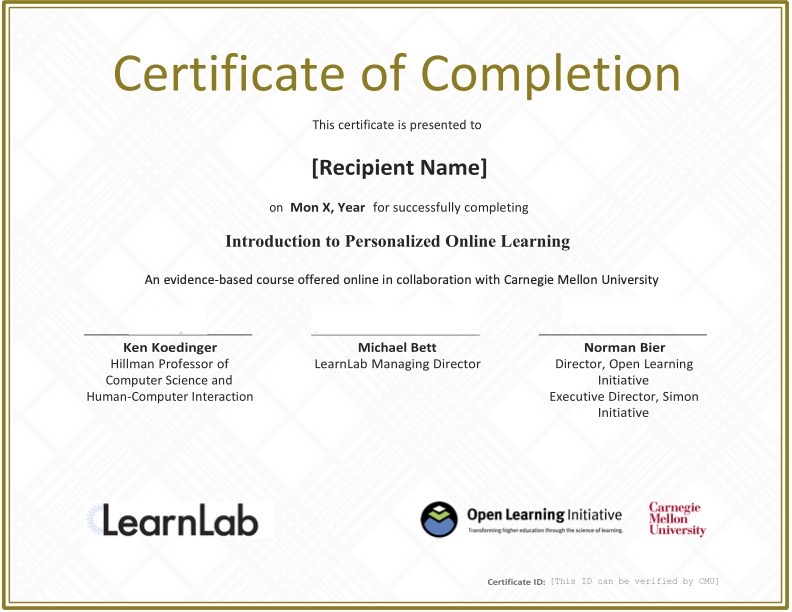Using Generative AI to Develop Active Learning Experiences


Start Any Time
Work on your pace and you will have instructors available to help you answer any questions.

Duration
Approximately 4 weeks, 6-8 hours/week

Fee
$500 introductory rate
Certificate Course Description:
In the rapidly evolving world of artificial intelligence, the power of Large Language Models (LLMs) like GPT-4 is reshaping how we approach education, content creation, and information processing. These models offer unparalleled advantages in generating educational content, answering queries, and providing tailored learning experiences. However, harnessing this potential requires a deep understanding of prompt engineering, model intricacies, and the principles of learning science. This course is essential for educators, developers, and content creators who want to stay ahead of the curve, offering a comprehensive guide to leveraging the capabilities of LLMs in the educational landscape.
In this course, you will embark on a journey through the intricacies of next-word prediction in LLMs, leading to effective sentence completion. You’ll master the art of prompt engineering, diving deep into zero-shot and few-shot prompting and understanding the nuances of refining prompts for optimized outputs. Using a top-down design approach, you will break down educational tasks and employ LLMs to craft enhanced learning materials. Furthermore, you’ll distinguish between LLM APIs and conversational chatbots, while delving into the nuances of hyperparameter tuning to perfect LLM outputs. By the course’s end, you will have the opportunity to apply your newfound knowledge in a two-step project, choosing from designing an educational tool, developing one technically, or creating a prompt engineering template, ensuring a holistic learning experience.
Module 1: Leveraging LLMs: Prompt Engineering, from Definition to Evaluation
- Articulate the process of next-word prediction in large language models leading to sentence completion
- Apply prompt engineering strategies to optimize the performance of Large Language Models (LLMs) in generating desired educational outputs
- Differentiate between zero-shot and few-shot prompting, explaining appropriate scenarios for their utilization
- Demonstrate how to refine prompts through additional instructions or context to shape the output of Large Language Models
- Critically evaluate the output from Large Language Models for reliability and accuracy, identifying potential instances of hallucination
Module 2: Top-Down Design: Implementing Educational Tasks with LLMs and Learning Science Principles
- Divide an educational task into subtasks as part of top-down design based on the concept of LLM chains
- Employ LLMs to generate tailored learning interactions and enhance existing learning materials in line with learning science principles
- Contextualize educational problems to match individual student interests in intelligent tutoring systems using large language models
Module 3: Integrating LLMs in Educational Tools: Practical Examples
- Differentiate between LLM APIs and conversational chatbots justifying the use of APIs in educational contexts despite the convenience of chatbots
- Analyze the implications of hyperparameter tuning in prompt engineering for optimizing the LLM outputs
- Temperature
- Top-k
- Top-p
- Number of tokens
- Repetition Penalty
- Presence Penalty
- Number of Examples
- Query Format
- Output Format
- Instruction Style
- Keyword Selection
- Utilizing DSPy for programming foundational models with minimal code to solve a given task
- Curating your educational dataset for training and validation
- Defining metrics for quality evaluation
- Create effective distractors for multiple-choice questions using LLMs that align with learning outcomes and target students’ misconceptions
Module 4: Course Project or Final Exam
At the end of the course, you’ll have an opportunity to do a two-step project from three choices based on area of your interest i.e Educational Tool Design (UX/UI), Educational Tool Development (Technical), or Prompt Engineering Template (Instructional Design). That will provide you with a nice experience to apply the fundamentals you will learn in the modules to a larger, more authentic, context. It will be graded by the instructor and you will receive personalized feedback.
None
Instructional designers, researchers developers, product/UX designers, and teachers who want to leverage large language models. Anyone interested in edtech.
What you'll learn
This course will help you:
- Apply prompt engineering techniques to optimize desired educational outputs such as creating effective distractors for multiple-choice questions.
- Design and decompose educational tasks into LLM-chain subtasks, ensuring alignment with core learning science principles.
- Utilize LLM APIs through DSPy for programming foundational models with minimal code to solve a given task, understanding its benefits over conversational chatbots.
- Assess the reliability and accuracy of LLM outputs, recognizing and addressing instances of potential model hallucination.
- Design and execute a capstone project applying the knowledge acquired, within the realms of Educational UI/UX Design, API Programming, or Instructional Design.
Course Instructors

Gautam Yadav
Gautam Yadav is a Learning Engineer in Carnegie Mellon’s Human-Computer Interaction Institute (HCII) specializing in creating effective evidence-based educational technologies and improving data-driven learning experiences for more than 3 years. He has published papers on leveraging large language models and utilizing them for scaling instructional design and AI literacy among middle school students.
Certificate
Upon successful completion of the program, participants will receive a verified digital certificate of completion from Carnegie Mellon University’s Open Learning Initiative.

In addition to the knowledge and immediately applicable frameworks you will gain by attending your selected courses, you will benefit from:
- A digital, verified version of your Executive Certificate (Smart Certificate) you can add to your resume and LinkedIn
- Networking with a global group of your peers and instructors for advancing your career
Register Now
Register and start taking the course in two steps:
1. Enter your email address
2. Make a payment at https://buy.stripe.com/4gw8zRed5gTn6Lm6oo
3. You will receive an access code via the email you made payment with along with the link to the course.


